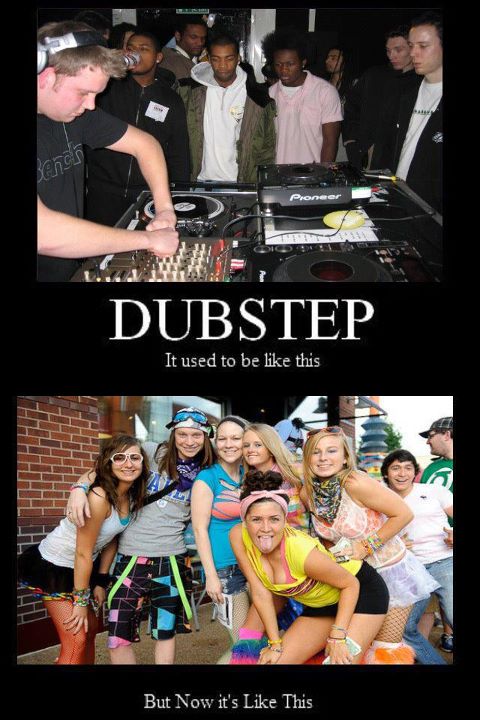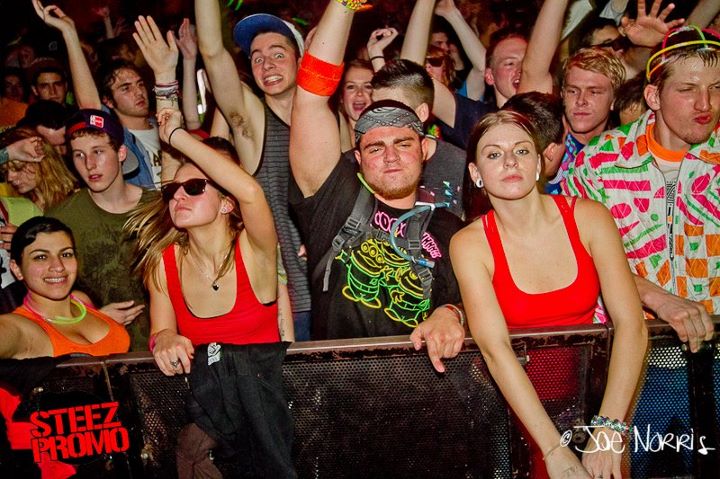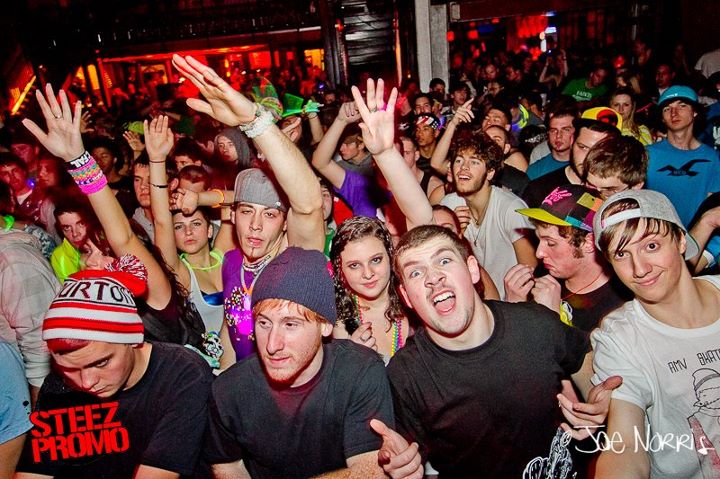You may not be a fan of the wub-wub-wubbing musical genre known as dubstep, but it is increasingly taking center stage in American popular culture. For example, a recent NorthFace advertisement uses it while a snowboarder glides down a snowy mountainscape, Britney Spears and Rihanna have both incorporated some dubstep into their recent work, teen heartthrob Justin Bieber is rumored to be working on his own dubstep album, and the teaser trailer for the new Mission Impossible film features a distinct wub-wubbing in the background. So what is dubstep anyway? And where did it come from?
Dubstep Goes to College
Dubstep was conceived in the London dance music scene in the late 90s and early 00s. It takes mainly from drum and bass and grime genres, but is influenced by many different styles of music, including dancehall and hip-hop. The heavy influence of grime, the dark elements of drum and bass and the guttural bass lines give it an almost dirty sound. This along with the layer of synthesizers are what people in the scene refer to when they describe the music (or party) as “grimey.”
Dubstep entered the mainstream club scene in 2006 in great part with the release of producer Oliver Jones’ (aka Skream) debut album “Skream,” which took club culture by storm in Europe (Woolliams 2008). The album also became widely popular in the United States EDM (electronic dance music) scene.

The EDM scene itself has grown increasingly popular in the United States, although not in the same magnitude as in London or other European cities. However, with dubstep’s increasing popularity this may soon change dramatically. Dubstep’s growing popularity seems to be the greatest among college students, especially fraternities, who have helped popularize the musical genre across college campuses in the US. This is because dubstep lends itself nicely to inebriated frat parties: one can dance or drone off to it’s characteristic throbbing bass in between shotguning beers and bouts of competitive fist-bumping.
The aggressive, wobbling bassline of dubstep, as well as its spectacular use of crazy robot “noises” translates quite seamlessly to the rambunctious college party scene. Cultural producers like MTV have certainly taken quick notice of this and are ready to market, what core members of the EDM subculture have disdainfully labeled as “brostep,” to these new consumers. Brostep incorporates a massive amount of the characteristic wobbling bass, which is exemplified in the latest work of DJs like Skrillex, Rusko, Caspa, and Borgore.
Steez promo is a good example of the use of marketing to target the mainstream college demographic. As a production company that started with underground raves and parties in downtown Baltimore, Steez Promo became a hit within the fledgling EDM subculture in the mid-late 2000s. Their early parties were thrown at band practice spaces and warehouses for $10, where you could bring in a 40 oz. or a handle of Bourbon to hang out with friends and dance the night away. In those days you could see dubstep artists like Rusko (who now collaborates with the likes of Britney Spears, Rihanna, and T.I.) in a small, cramped, non-descript space. It was still very much an underground scene.
Steez Promo, quickly realizing the growing popularity of dubstep in popular music, began to flyer college campuses like Towson University and University of Maryland. They seized the opportunity to tap into this burgeoning marketplace niche, and began throwing monthly parties at an expensive venue, Bourbon St., and expanding to Philly and then DC, where the average ticket for a show is now $25. The vibe of these shows, aptly named “Dub Nation,” is, of course, quite different from the dance parties they started with, and which are still thrown by grassroots promoters in the underground EDM scene.
The Rise of “Brostep”
The term “brostep” has been used to describe the most recent wave of popular dubstep music which gained notoriety through Best Buy, Audi, and BMW advertisements, as well as other forms of mass media exposure, and which also heavily relies on predictable rhythmic patterns obviating the need for melodic content. However, the addition of DJs who spin this type of dubstep and are “second adopters” (Postrel 2003) comes as a threat to earlier adopters of this musical genre, who have largely incorporated elements of the subculture into an overarching lifestyle project (Thornton 1996). Some of these “hardcore” members even describe EDM raves and parties as rituals of community engagement and togetherness, sites of Durkheimian effervescence and spiritual connectivity (Durkheim 1912).
The inclusion of new members is perceived as a threat to this established community order, especially since the new listeners don’t have a particular experience or ideology attached to the music. Dubstep has been abstracted from its context and a spectacle of sound has been produced in order to attract people who are not at the EDM events but are listening to the radio or their computer speakers.
As a veteran of the EDM scene and music producer himself, Dan Vibeage from Aligning Minds describes the nature of dubstep as being “more about the subtlety and the nuances between the drums, spacey atmospheres, and deep basslines.” He goes on to say,
It was music designed to be played on huge, bass heavy sound systems so that the sub bass could be re-produced and that’s how it was best experienced. A lot of the basslines were so deep that if you played them on, say, laptop speakers, you wouldn’t hear half of the music going on because the subs weren’t being reproduced. The subs are what make it ‘drop’ and create excitement, and depth and energy.
In sociological terms, this distinction between brostep and dubstep serves to divide second adopters from earlier adopters and those who identify as “core” members of the subculture (Chalmers and Arthur 2008). In this way, taste (Bourdieu 1984) comes to define one’s membership in the EDM community, with “brostep” pejoratively applied to those whose attraction to dubstep is linked to more recent artists like Skrillex or Borgore. For example, the audio track below reveals Rusko, arguably a forefather of the brostep subgenre, distancing himself from the genre.

Much like Thornton’s (1996) research on the London club scene in the early 90s, “brostep” can also serve as a moniker for “the mainstream,” the passive clients of the culture industry who do not have the refined tastes of the core subculturalist. In this way, the “brostep” label serves as a social distancing mechanism. Purists within the subculture thereby create ever more subtle distinctions in order to protect their field-dependent identities as consumers from the intrusion of new members (Arsel and Thompson 2010). This helps members of subcultural groups maintain a source of distinction from the mythologized mainstream (Thornton 1996).
However unlike Thornton’s (1996) study, where DJs themselves served as the “taste arbiters” of the community, setting the trends and helping to define the subculture’s subsequent development, in the case of “brostep” the perceived taste arbiters are mostly cultural producers and record companies, the petite bourgeoisie of the culture industry and the mass media (Featherstone 1991). In this sense, subcultural forms come to be seen as produced from afar (corporations, capitalism), rather than organic products of members of the subculture (because DJs are the creators of music, and music translates into subcultural capital in music subcultures [Thornton 1996]). To some members of the EDM community, the intrusion of brostep is a threat. Many fear their culture may be hijacked by outsiders, and some even abandon the genre altogether.
Dan Vibeage also recounts the role of Web 2.0 and new technologies in facilitating the development of brostep as a subgenre of dubstep. He states,
In 2006 we had a number of producers making this new sound with a focus on space and bass. Each producer had his own take on how to do it, but they were all making spacey, dark music for big big speakers. With a little help from the internet, the genre grew because it was so unique. But in growing, it also evolved.
The relaxed, dubby vibe got pushed aside to make way for more. More wobble, more sounds, more everything. Maximize to maximize. Along came crappy speakers. Radios, laptops and white earbuds. No point in making bass sounds for something that can’t play low frequencies. So we throw in a bunch of electronic “filth” sounds. Take the overtones of the wobble and make them the focus. Wobble noise. Wobble anything that can be heard on laptop speakers. The result? Something that sounds like dubstep, except they took out all the deep parts and replaced with immediately digestible ‘fast food’ sounds is how I would think of them.
Hence, [there is] a pretty big musical divide between dubstep (bass and space) and brostep (in your face) – a lot of the ‘depth’ is gone – but of course this is relative, it depends on what you like!
Part 2
From Screamo to Brostep: The Case of Skrillex

The popularization of dubstep is further epitomized in the wildly popular, albeit polarizing example of Sonny Moore, former lead singer/frontman of the 2000s screamo band From First to Last. He left the band in 2004 to pursue his solo career only to return in 2008 as the dubstep DJ Skrillex, when dubstep was beginning to “blow up” in American popular music. He quickly became an internet phenomena, an early harbinger of the recent “brostep” wave of popularization which would later be bolstered by user-generated dubstep videos using footage from the Transformers movies. And at the 2011 MTV Music Awards, he walked away with the award for Best New EDM Artist as a result of his popularity under the stage name Skrillex.
Upon hearing of this award, many in the EDM community were outraged. Why? Because many members of this subculture viewed him as an outsider who solidified dubstep as pop music played on radio and television stations, making the subculture open and accessible to most everyone. Most in the EDM community have never seen him as an organic member of the underground dubstep or EDM subculture. Skrillex is simply the product of mainstream capitalism taking notice of dubstep as a viable market commodity. His popularity and success coincides directly with the most recent wave of popularization occurring in the late 2000s, his five recent Grammy nominations notwithstanding.
Much of the animosity displayed towards Skrillex (and the “brostep” musical trends he represents, as a late adopter) arises from his calculated image change between 2007 and 2008. Despite the fact that he was a young teen at this time (he began fronting From First to Last at age 15), Sonny’s stylistic change from screamo to EDM violates principles of subcultural authenticity (Thornton 1996). That is, one cannot “change” scenes without raising questions of one’s credibility. Where subcultural authenticity is so often linked to early adoption of subcultural forms (Arthur 2004; Thornton 1996), rapid stylistic changes such as those displayed by Mr. Moore come to be interpreted as evidence of inauthenticity. Furthermore, both his “First to Last” and “Skrillex” careers began when these genres (screamo/dubstep) had been around long enough to become popular and marketed by major labels of the music industry.
But this trend is also quickly becoming the norm, as David Muggleton’s (2002) research on postmodern subcultural forms suggests. As Muggleton (2002) discovers, individuals often trace their identities through various subcultural and musical groups, suggesting that just as identity is always in process, so is our sense of style and self-presentation. This is important because subcultural style and self-presentation serve as external indicators of taste that we display to others as signs. And taste is increasingly used to self-segregate into increasingly specialized taste publics (Gans 1974)
Taste and Distinctive Individualism in the Postmodern Era
Former subcultures like those associated with dubstep and EDM culture become a repository of collective aspirations for distinction in the postmodern era. David Muggleton (2002) describes contemporary identity as based on “distinctive individuality,” or a desire for uniqueness amidst larger group affiliations like subcultures (Muggleton:64). We choose to display ourselves to others through the subtle manipulation of our presentation of self, which presumes our commandment over symbolic and cultural resources like clothing, music, food, and other indicators of taste (Bourdieu 1984). All of our consumption choices, including our taste in music, come to wield symbolic influence over what we “say” to others. In essence, it is how we construct our very selves in the postmodern hyperspace (Jameson 1991), by saying to others what “type” of person we are. What is unique about distinctive individualism, however, is that it allows individuals to claim both group allegiance (ie: conformity) while simultaneously allowing space for individual deviation (ie:uniqueness).
Furthermore, with the fast appropriation of subcultural forms–their music, fashion, and other lifestyle indicators–for profit making, it is increasingly difficult for subcultural members to maintain these sources of distinction that once gave them a stable sense of identity. With the advent of Web 2.0 (especially file-sharing programs like KaZaA or BitTorrent), subcultures have in some sense been “opened up” and democratized. Entry into subcultural groups has become much easier, as expanded access to cultural products (think easily downloadable mp3s) lends itself to autodidactism, or a self-directed socialization of taste (Bourdieu 1984). With more information comes greater diffusion of subcultural goods and services, and thereby less chance for individual members to display cultivated knowledge or appreciation for all things underground. In “instant society” (Postrel 2003), things don’t stay within a subculture for long before they are picked up by cultural producers like MTV, appropriated, abstracted, and then commodified for sale to a much larger audience.
However, this does not mean that the principles of subcultural distinction are moot, or that subcultures are completely “dead” (Clark 2003). First, the backlash against brostep from core dubstep enthusiasts reiterates Bourdieu’s telling observation about taste, namely, that our dislikes say more about us than our actual taste preferences (Bourdieu 1984; Thornton 1996). In this way, the backlash against “bro-step” serves to identify the proclaimer as something else entirely, a different “type” of person. When someone says they like dubstep, but not “bro-step,” they are attempting to differentiate themselves from later adopters, who apparently value “the drop” over other elements of dubstep. As one critic of bro-step explains
“Valuing ‘the drop’ is a bunch of crap that has no musical value,” Georgetown University student Franco Nuschese said. “Any Jabroni (like myself) can create a sick-ass drop with free audio programs online.”
According to this logic, the true dubstep enthusiast appreciates more than simply wob-wobbling base and a nice hook.
Secondly. the derogatory label of “bro-step” serves as a social distancing mechanism for individuals who view themselves as core dubstep enthusiasts. This is similar to other findings over other subcultural groups. For example, in their research on the Harley Davidson “subculture of consumption,” Schouten and McAlexander (1995) found that core bikers used the epithet of SEWER (“suburban weekend rider”) to distance themselves from newer middle-class consumers they labeled as yuppies. Similarly, DeMello’s (2000) research into the tattoo community revealed the distinction between tattoo artists and “scratchers,” the latter serving as an epithet for working-class (ie: “biker”) tattooing.
So in actuality, the term “bro-step” largely serves as an attempt to preserve accumulated subcultural capital (Thornton 1996). Core members of the EDM community, especially those who consider themselves dubstep enthusiasts, must continually remake standards of taste in subcultural groups, in order to defend their field-dependant identities from new consumer groups attracted to their subcultural forms (Arsel and Thompson 2010). In this case, dubsteppers feel threatened by the incorporation of new members into their subcultural milieu. They react by labeling these encroachers (who happen to be largely suburban college youth) “bros” and vilifying their musical forms as “bro-step.” As stated in the first half of this paper,, this allows individuals who identify with the dubstep subculture the ability to cultivate increasingly obscure tastes, retreating into the recesses of the subculture in search of “untarnished” subcultural forms (in this case, underground dubstep music, limited releases, and underground parties).

Conclusion:
Subcultural Distinction in an Era of Mass Marketization
The dub/bro-step distinction is a conflict of taste. People in the EDM scene don’t want to be seen as having the same music taste as everyone else (represented by the “bros” of the mainstream) because this would affect their status as subcultural insiders. The mass popularization of dubstep precludes the development of a perceived “unique” identity (aka: that which is alternative from the mainstream masses and hence a source of “distinctive individuality” in the postmodern cultural climate [Muggleton 2002]). It serves to obliterate the source of distinction (ie: one’s refined taste in subcultural forms; one’s active participation in the community) that made one a member of a subculture in the first place. Instead, one finds that their own unique tastes are not so unique after all. The postmodern desire for distinctive individualism, the desire for both uniqueness and affiliation, becomes readily apparent in such debates.
Dubstep is no longer a musical genre that distinguishes someone as different from the mainstream, but one that actually connects them to it. Dubstep, then, is no longer connected to a particular experience (rave/festival), way of life, or ideology, but is abstracted from its context and marketed as pop (ie: “the mainstream”), which induces subculturalists to distance themselves from the genre or to pejoratively label recent releases as “brostep.” Those who want to preserve their subcultural capital simply retreat to the musical horizons, seeking producers that are still unknown and are thus seen as legitimate–such subcultural purists are forever running from the pop charts by seeking ever-more underground DJs as a source of subcultural authenticity (Thornton 1996).
However, there are also those within the EDM community who accept that dubstep has been appropriated by the mainstream as the anthem for today’s youth. They see it as the new rock n’ roll, a generational movement in taste and self-expression, and a musical form that can bring everyone together.
We also believe the polarizing effect of brostep encapsulates a much larger tension between subcultural authenticity and mass-marketization (ie: selling out). When subcultural authenticity so often simplifies to “difference from the mainstream,” it comes as no surprise that the increasing popularity of dubstep in new social circles has exacerbated tensions within the EDM community, creating an identity crisis of sorts for early adopters of this musical genre. So the question that remains is how will subcultures survive in an era of web 2.0 and the opening up of formerly “underground” groups and scenes? With distinctions between sub/mainstream culture increasingly blurring (largely as a result of the mass marketization of subcultural forms), does it even make sense to refer to subcultures as such? Or do we need a new term for contemporary taste publics (Gans 1974) like those that surround dubstep?







Comments 12
Julia — January 27, 2012
I wonder why all of the photos that show the "degradation" or of the genre filled with young women (except the Borgore performance), and all of the photos of the authentic, original version are filled with men? Are these photos representative? Or chosen to point out this dynamic (although not specifically addressed in the text)?
Augie — February 15, 2012
I'm writing an extended essay on dubsteps impact on pop culture could you send me any sources you have found or any tips . it need to be an argumentitive essay and i need help thanks
The Rebirth of the Legend?Aqua Lung?s Newest Regulator Series | My Gov UK — May 16, 2012
[...] twitch stenberg mat hoffman ride bmx concrete disciples mike aitken gagnier freestyle moto x boarder jeremy crapo van homan espn tv [...]
Kids vil have dubstep | Bloggers By Choice — May 18, 2012
[...] er bl.a. populær, fordi den passer perfekt til festkulturen på kollegierne, kan man læse i dette essay, hvor udviklingen fra hemmelig genre til mainstream [...]
Kroppen och musiken | Dicore — September 6, 2012
[...] och Swedish House Mafia gjorde genren populär. Som David Paul Strohecker och Ibalu Dwan skriver i The Society Pages (som förövrigt gör en utmärkt Durkheim-m.fl. analys av genren), passade de wobblande ljuden och [...]
Caroline — October 26, 2012
I am actually a HUGE fan of Skrillex and after reading this I am now craving loud speakers and the original dubstep. I literally listen to the new age dubstep all the time and if I think that it's amazing now, I can't wait to hear what it once was. Do you have any links to any original dubstep? I am extremely interested to hear this.
Hecatom — March 4, 2013
This whole stuff about the scene having to deal with the income of brostep fans reminds me of the 80's and how the metal scene had to deal with all the hair metal fans
Armands — March 29, 2013
Thanks for the great article.
There was a big issue for me how to call Skrillex DUBSTEP because it is not real dubstep - now I know - it is BROSTEP.
Thanks Wil for the great examples of real dubstep in youtube! I LIKE it too :)
Bro, Do You Even Step? | dropthesalmon — May 16, 2014
[…] Strohecker, David(2012). The Popularization of Dubstep. The Society Pages. Retrieved on the 12th May, 2014 from: http://thesocietypages.org/cyborgology/2012/01/21/the-popularization-of-dubstep-full-essay-parts-1-a… […]